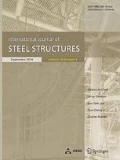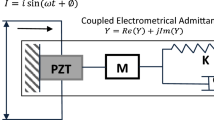Abstract
A technique to detect the bolt looseness in steel frame using the transfer impedance technique, which is a dual piezoelectric material technique, for bolted joint structural health monitoring is experimentally studied. An expensive impedance analyzer should be used to employ the single piezoelectric material technique (SPMT) while a general function generator and a digital multimeter can be used to employ the transfer impedance technique. Therefore, the low-cost fault detection could be carried out. A steel frame consisting of high tensile bolted connections with the splice angles was made, and the preload forces of the bolts were gradually reduced and the damage tests were carried out. The damage indexes were obtained using the transfer impedance technique and it was found that the fault existence of the bolted joint could be reasonably detected and the variations of the damage indexes tend to be increased as the degree of bolt looseness increases. The estimation results were similar to the results of the SPMT using the impedance analyzer. These results support that it is possible to estimate the bolt looseness of the bolted joint based on the impedance technique at low-cost, excluding an expensive impedance analyzer. It could be used effectively for bolted joint structural health monitoring if the study on identification of fault location and severity using the transfer impedance technique is supplemented in the future.
















Similar content being viewed by others
References
Bhalla, S., Gupta, A., Bansal, S., & Garg, T. (2009). Ultra low-cost adaptations of electro-mechanical impedance technique for structural health monitoring. Journal of Intelligent Material Systems and Structures, 20, 991–999.
Dziendzikowski, M., Niedbala, P., Kurnyta, A., Kowalczyk, K., & Dragan, K. (2018). Structural health monitoring of a composite panel based on PZT sensors and a transfer impedance framework. Sensors (Basel, Switzerland), 18, 1521–1537.
Jung, H. K., Jo, H. J., Park, G., Mascarenas, D. L., & Farrar, C. R. (2014). Relative baseline features for impedance-based structural health monitoring. Journal of Intelligent Material Systems and Structures, 25, 2294–2304.
Kim, J. T., Park, J. H., Hong, D. S., & Ho, D. D. (2011). Hybrid acceleration-impedance sensor nodes on Imote2-platform for damage monitoring in steel girder connections. Smart Structures and Systems, 7, 393–416.
Liang, C., Sun, F., & Rogers, C. A. (1996). Electro-mechanical impedance modeling of active material systems. Smart Materials and Structures, 5, 171–186.
Min, J., Park, S., Yun, C. B., Lee, C. G., & Lee, C. (2012). Impedance-based structural health monitoring incorporating neural network technique for identification of damage type and severity. Engineering Structures, 39, 210–220.
Nguyen, T. C., Huynh, T. C., Yi, J. H., & Kim, J. T. (2017). Hybrid bolt-loosening detection in wind turbine tower structures by vibration and impedance responses. Wind and Structures, 24, 385–403.
Park, G., & Inman, D. J. (2007). Structural health monitoring using piezoelectric impedance measurements. Philosophical Transactions of the Royal Society, 365. 373–392.
Pavelko, I., Pavelko, V., Kuznetsov, S., & Ozolinsh, I. (2014). Bolt-joint structural health monitoring by the method of electromechanical impedance. Aircraft Engineering and Aerospace Technology: An International Journal, 86, 207–214.
Shao, J., Wang, T., Yin, H., Yang, D., & Li, Y. (2016). Bolt looseness detection based on piezoelectric impedance frequency shift. Applied Sciences, 6, 298–308.
Song, H., Ling, H. J., & Shon, H. (2013). Electromechanical impedance measurement from large structures using a dual piezoelectric transducer. Journal of Sound and Vibration., 332, 6580–6595.
Tawie, P., & Lee, H. K. (2010). Piezoelectric-based non-destructive monitoring of hydration of reinforced concrete as an indicator of bond development at the steel–concrete interface. Cement and Concrete Research, 40, 1697–1703.
Yin, H., Wang, T., Yang, D., Liu, S., Shao, J., & Li, Y. (2016). A smart washer for bolt looseness monitoring based on piezoelectric active sensing method. Applied Sciences, 6, 320–329.
Acknowledgements
This work was supported by the National Research Foundation of Korea (NRF) grant funded by the Korea government (MSIT) (No. 2017R1A2B4006722).
Author information
Authors and Affiliations
Corresponding author
Additional information
Publisher's Note
Springer Nature remains neutral with regard to jurisdictional claims in published maps and institutional affiliations.
Rights and permissions
About this article
Cite this article
Lee, JW. An Experimental Study on Bolt Looseness Monitoring Using Low-Cost Transfer Impedance Technique. Int J Steel Struct 21, 349–359 (2021). https://doi.org/10.1007/s13296-020-00442-1
Received:
Accepted:
Published:
Issue Date:
DOI: https://doi.org/10.1007/s13296-020-00442-1




